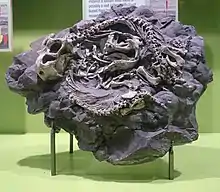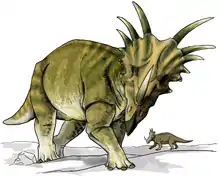1913 in paleontology
Paleontology or palaeontology is the study of prehistoric life forms on Earth through the examination of plant and animal fossils.[1] This includes the study of body fossils, tracks (ichnites), burrows, cast-off parts, fossilised feces (coprolites), palynomorphs and chemical residues. Because humans have encountered fossils for millennia, paleontology has a long history both before and after becoming formalized as a science. This article records significant discoveries and events related to paleontology that occurred or were published in the year 1913.
| |||
|---|---|---|---|
| +... |
Insects
| Name | Novelty | Status | Authors | Age | Unit | Location | Notes | Images |
|---|---|---|---|---|---|---|---|---|
|
sp. nov |
Synonym |
von Rosen |
A Stylotermitid termite. synonym of Parastylotermes robustus |
|||||
|
Protosmylus picta[3] |
Gen et comb. nov |
Synonym |
(Hagen) |
A protosmyline Osmylid lance lacewing |
||||
Vertebrates
| Name | Status | Authors | Age | Unit | Location | Notes | Images |
|---|---|---|---|---|---|---|---|
|
Valid |
Pristerognathus zone |
A dicynodont belonging to Pylaecephalidae, living in burrows. |
|||||
|
Junior synonym |
Robert Broom |
Junior synonym of Rhachiocephalus. |
|||||
|
Valid |
Broom |
Late Permian |
|||||
|
Valid |
Broom |
Late Permian |
A member of Gorgonopsia. |
||||
| Name | Status | Authors | Age | Location | Notes | Images |
|---|---|---|---|---|---|---|
| Aggiosaurus[4] |
Valid |
|
157 million years ago | |||
| Plesiosaurs | ||||||||||||||||||||||
|---|---|---|---|---|---|---|---|---|---|---|---|---|---|---|---|---|---|---|---|---|---|---|
|
| |||||||||||||||||||||
Data courtesy of George Olshevsky's dinosaur genera list.[5]
| Name | Status | Authors | Location | Notes | Images | |
|---|---|---|---|---|---|---|
|
Probable a misidentified bird, but may be a troodontid dinosaur. |
|||||
| Hypacrosaurus[7] | Valid taxon | |||||
| Procompsognathus[8] | Valid taxon | a Coelophysoid. | ||||
|
Disputed. |
|
Possible junior synonym of Procompsognathus. |
||||
| Styracosaurus[10] |
Valid taxon |
A horned ceratopsian. | ||||
| Thescelosaurus[11] | Valid taxon |
|
A small, agile Ornithopod. | |||
Expeditions, field work, and fossil discoveries
- April: William Edmund Cutler prospected in Dinosaur Provincial Park. His work was underwritten by the Calgary Syndicate for Prehistoric Research, a group of local philanthropist businessmen, and a small local museum, the Calgary Public Museum, which no long exists.[12]
- Summer: The American Museum of Natural History dispatched a team of fossil hunters to Dinosaur Provincial Park. Cutler joined the expedition but was "asked to leave" after only a few months of involvement.[12]
- Cutler excavated a juvenile Gryposaurus now catalogued by the Canadian Museum of Nature as CMN 8784. The site of the excavation has since been designated "quarry 252".[12]
- Winter: Cutler partly prepared the young Gryposaurus specimen, possibly in Calgary while working on dinosaurs for Euston Sisely.[12]
- A US Geological Survey crew headed by Eugene Stebinger and a US National Museum crew headed by Charles Gilmore worked together to excavate the first dinosaur discovery of the Two Medicine Formation.[13]
See also
References
- Gini-Newman, Garfield; Graham, Elizabeth (2001). Echoes from the past: world history to the 16th century. Toronto: McGraw-Hill Ryerson Ltd. ISBN 9780070887398. OCLC 46769716.
- Emerson, A.E. (1971). "Tertiary fossil species of the Rhinotermitidae (Isoptera), phylogeny of genera, and reciprocal phylogeny of associated Flagellata (Protozoa) and the Staphylinidae (Coleoptera)". Bulletin of the American Museum of Natural History. 146 (3): 243–304.
- Makarkin, V.N.; Archibald, S.B.; Mathewes, R.W. (2021). "New Protosmylinae (Neuroptera: Osmylidae) from the early Eocene of western North America, with taxonomic remarks". Zootaxa. 4980 (1): 142–156.
- Ambayrac, M. 1913. Une machoire de grand Reptile du Jurasique supérieur (Oxfordien). [journal title unknown]: pp. 97-98.
- Olshevsky, George. "Dinogeorge's Dinosaur Genera List". Archived from the original on 2011-07-15. Retrieved 2008-08-07.
- Andrews, C.W. (1913): On some bird remains from the Upper Cretaceous of Transylvania. Geological Magazine 5: 193-196.
- Brown, B. 1913. A new trachodont dinosaur, Hypacrosaurus. from the Edmonton Cretaceous of Alberta. Bull. Am. Nat. Hist. 32: pp. 395-406.
- Fraas, E. 1913. Die neuesten Dinosaurierfunde in der schwabischen Trias. Naturwissenschaften 45: pp. 1097-1100.
- Jaekel, O. 1913/1914. Uber die Wirbeltierfunde in der oberen Trias von Halberstadt. Paläontologische Zeitschrift 1: pp. 155-215.
- Lambe, L. M. 1913. A new genus and species of Ceratopsia from the Belly River Formation of Alberta. The Ottawa Naturalist 27 (9): pp. 109- 116.
- Gilmore, C.W. 1913. A new dinosaur from the Lance Formation of Wyoming. Smithsonian Misc. Coll. 61: pp. 1-5.
- D. H. Tanke. 2010. Lost in plain sight: rediscovery of William E. Cutler's missing Eoceratops. In M. J. Ryan, B. J. Chinnery-Allgeier, D. A. Eberth (eds.), New Perspectives on Horned Dinosaurs: The Royal Tyrrell Museum Ceratopsian Symposium. Indiana University Press, Bloomington 541-550.
- Trexler, D., 2001, Two Medicine Formation, Montana: geology and fauna: In: Mesozoic Vertebrate Life, edited by Tanke, D. H., and Carpenter, K., Indiana University Press, pp. 298–309.



